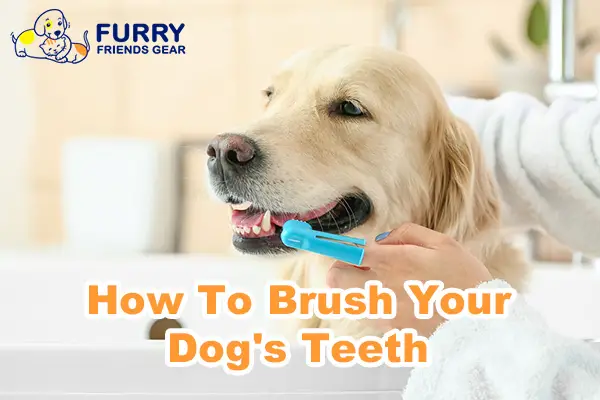Just like humans, dogs also must have excellent oral health to contribute to their overall wellness. The most critical aspect of oral hygiene is that of brushing. And, as a pet owner, it is our job to learn the best ways of how to brush dog’s teeth.
But…
like your toddler at home, brushing your dog’s teeth is never a walk in the park. Dog’s dental health requires routine brushing as well as a regular professional dental cleaning.
In this article, we will talk about
- When to start teeth brushing
- What to use
- Tips for teeth brushing
- How often to get dog teeth brushed
- Why dog oral care is so important
- and more
So, enough of the introduction, ready to get start brushing? Let’s dive in!
When to Start Brushing?
Although different dog breeds have varying brushing needs, the best time to start is as soon as possible. Start them young because dogs need an extended period to get used to the process. It is usual for the canine to feel uneasy and uncomfortable at first, but that will change.
Now if you start late, there’s a possibility for your pup never to learn to adjust and like the brushing routine. This is when dog owners tend to give up.
It’s best to implement daily brushing of your dog’s teeth. This daily routine will help prevent tooth decay, help minimize plaque buildup and keep your pet’s teeth in great condition. And, as you and your pet get used to this routine, it will become an easy task for more pets.
For most veterinarians, brushing at least three times a week is a modest approach and is more than enough to keep plaque from building up and food debris from getting trapped in between the teeth.
It makes perfect sense to transition your dog from being uncomfortable to entirely at ease with tooth brushing while it’s still a puppy. As the adage says, “you can’t teach an old dog new tricks.” While you can still force an older dog to brush, the training will be more extended and challenging. Nonetheless, it’s still worth the effort and will ultimately keep future health problems to a minimum.
What to Use When Brushing
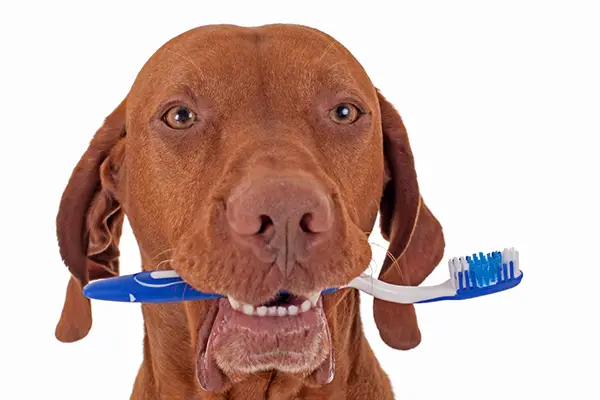
The first rule in brushing your dog’s teeth is never to use a toothbrush intended for humans. While you think there’s nothing wrong with it, the reality is that it might not work, or it could even hurt the gums.
There are many options for pet friendly toothpaste and brushes. Be sure to choose one that comes with soft bristles. If you think it’ll be challenging to use a conventional shape, you can opt for a finger brush instead. Don’t forget to moisten the brush before you start as it minimizes the discomfort.
Below is a recommended tooth brush to consider using to keep your dog’s oral health in tip-top shape:
Best Finger Toothbrush For Dogs
Jasper Dog 360º Finger Toothbrush
- Has a patented toothbrush design that allows easy teeth cleaning of the entire mouth with just a few swipes.
- Compact design works well on smaller dogs, cats, and puppies. Also works great for larger dogs as long as your finger can reach their teeth.
- Adding a few drops of water inside makes the silicone expand for larger fingers and creates a seal for smaller fingers.
How About the Toothpaste?
Just like the toothbrush, you never should use human toothpaste. Instead, use dog specific toothpaste. This is usually artificially flavored to taste like poultry, malt, and other stuff that dogs will like.
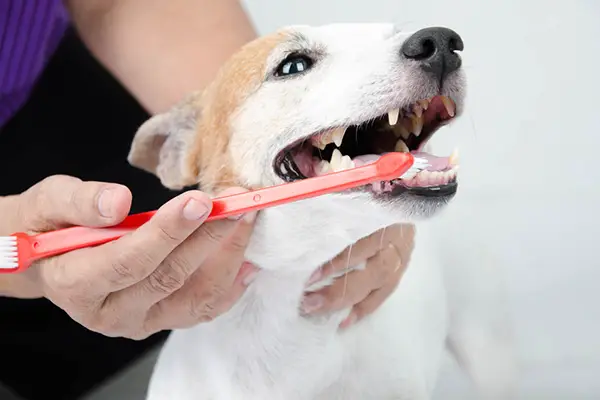
Remember,
some ingredients in human toothpaste, such as baking soda, salt, and xylitol, can cause an upset stomach for your pet, and in some severe cases, even poison your four-legged buddy.
Below is a recommendation for dog toothpaste that won’t wreak havoc on your dog’s stomach.
Best Veterinarian’s Approved Toothpaste For Dogs
Vet’s Best Enzymatic Dog Toothpaste
This toothpaste is flavored as banana. Some of the features include:
- Enzymatic Dental Gel Toothpaste is a veterinarian formulated soothing and effective mix of aloe, neem oil, grapefruit seed extract, baking soda, and enzymes.
- Freshens breath and gently cleans away plaque and tartar.
- Dogs love the great taste.
Tips On How To Brush Dog’s Teeth
Here are some more tips on brushing your dog’s teeth for the first time:
- It’ll help if you give your pet a small sample of the toothpaste. This is meant to introduce the taste, letting you know if you need to get something else. Sometimes, dogs are apprehensive of the taste, but it won’t take long to get used to the toothpaste. And, remember… DO NOT use human toothpaste.
- Gently lift your dog’s lip to expose the outer surfaces of the teeth and the gum line. These are the areas that don’t get much attention when brushing.
- Brushing must be characterized with extra gentle motions for cleaning the teeth and gums. Just think about how it’ll hurt if you put some force while brushing your teeth.
- Don’t forget the cheek-facing surfaces, too. This is a remedy as most dogs hate it when you brush the inside surface of their teeth.
- See to it that you reach the back teeth. This is the area where plaque and tartar build-up fast.
- One of the most proven ways of keeping your dog interested in the brushing session is to use rewards to acknowledge good behavior. The idea is to make it feel like it’s a pleasant experience. The reward may be in the form of a dental treat, playing, petting, or any positive reinforcement.
More Pro Tips in Brushing
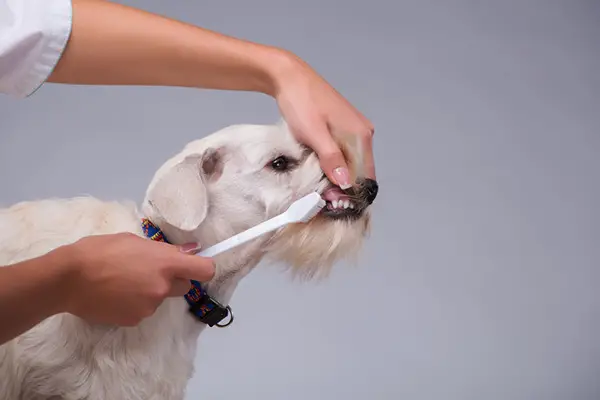
- Talking to your dog may sound silly, but it doesn’t cause any harm either while you brush your dog’s teeth. Praising your dog for being cooperative throughout the process makes a world a difference. It’s a form of reassurance, letting your furry buddy know that everything is fine.
- Pick a quiet time and peaceful setting. The same goes for the area inside your home. You have the luxury of securing your dog in your lap if it’s a small breed. Be sure that its head is facing away from you. In case you have a large breed like a Labrador Retriever or a Doberman, you’re better off sitting on a chair while your dog sits beside you. See to it that the animal’s mouth is within reach while you’re in a sitting position.
- Use finger brushes. Rubbing your finger with a brush on the teeth outside surfaces is a proven strategy to keep the pet comfortable. Using a back-and-forth motion, you first must focus on those areas where the gum contacts the tooth.
- Protect your fingers during your dental cleaning. When using a finger brush, keep your fingers on the outside surface of your dog’s teeth to minimize the likelihood of being accidentally bitten. Don’t rush it, your dog is sensitive enough to feel if you’re trying to speed up the process. The last thing you want is for it to get hurt or uncomfortable.
- Brushing the lower teeth requires a bit more effort. For this to work, you must open your dog’s mouth wider by gently tilting its head backward. Be sure that you’re holding his upper jaw with your thumb and index finger of your free hand to provide support.
- The key is to work your way up. When starting to introduce dental cleaning to pets as a routine to improve your dog’s health, you can start with cleaning just a few teeth. For example, focus on the front teeth. Most pets will become comfortable over time, then you can gradually work up to cleaning all of your pet’s teeth in a single session.
Teeth Cleaning at Home: How Often Should It Be Done?
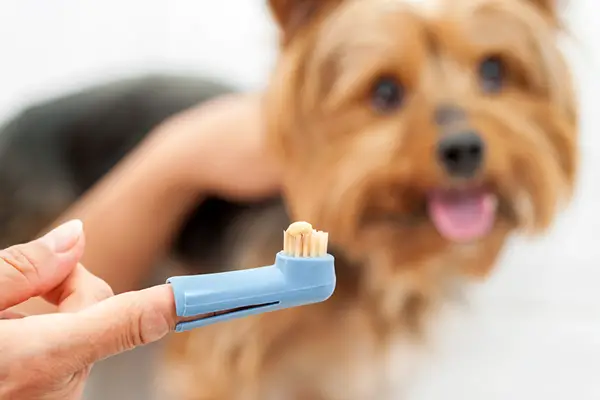
We’ve already mentioned that you ought to brush your dog’s teeth as often as possible. In a perfect world, it must be done daily. On the other hand, vets and dentists agree that brushing at least three times a week will suffice.
Because your pet eats every day, it means that the teeth are always prone to collecting food debris, which in turn can turn up as plaque without you noticing it. Having an easy to implement routine is the easiest way to clean the teeth without hassle.
Besides brushing, you can incorporate reinforcements, especially when you have a stubborn dog at home that doesn’t like brushing. For instance, you can buy dog teeth cleaning toys and dental treats. The best thing about dental chews and toys is that you don’t have to intervene or do a “hands-on” dental cleaning.
Dogs like munching and gnawing on anything, so giving them something they love is convenient. Chews and toys promote saliva production, and they break down food particles before becoming plaque.
Also, keep in mind that some breeds with flat and broad snouts, for example, bulldogs or pugs, require more frequent brushing. These breed’s small mouths mean that they have crowded teeth, making them more prone to plaque build-up.
Why Avoid Baking Soda?
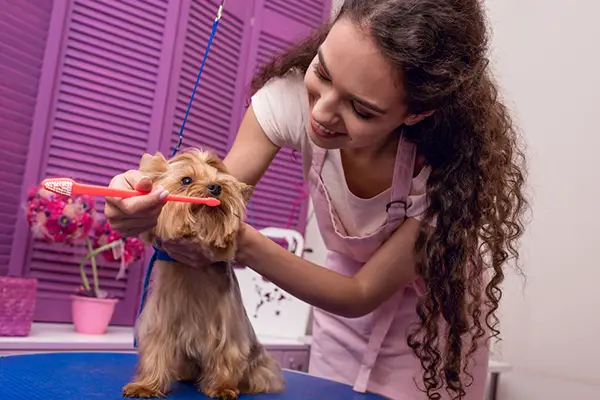
You might have come across some tips online on the use of baking soda. We all know that it is an effective cleaner. And, as humans, we even use toothpaste with it. That’s probably why some people think it’s a good idea to use for their four legged friends.
When used as toothpaste for dogs, the problem is that it’ll upset your pet’s digestive tract if the animal swallows it. This is because baking soda has a relatively high alkaline content that disrupts the acid balance in the stomach.
If you use baking soda and your dog feels ill right after, there’s a chance that your dog will become stubborn in the next session. So, don’t be like other dog owners who made this critical mistake.
Professional Cleaning By Your Veterinarian
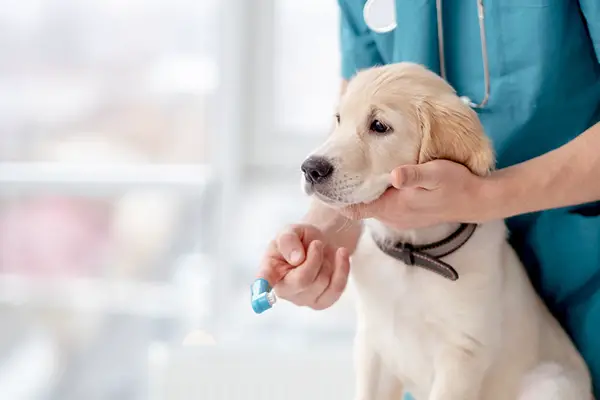
Contrary to what some dog owners think, at-home dental care is not always enough to keep your dog’s teeth clean. Some factors contribute to the need for professional teeth cleaning, most notably your dog’s diet.
Yes,
you’ve heard it right: dogs require professional cleaning once a year, just like humans do.
Take your best buddy to the veterinarian for a thorough cleaning. Professional cleaning by your veterinarian allows them to use the right tools to get the inner surfaces, really get the gum line clean, and get a few teeth that you have a hard time cleaning.
This is crucial to prevent the onset of gingivitis and remove the tartar build-up. Not many pet owners realize, but gum disease breeds bacteria, which in turn may find their way to the organs and lead to death. If you see light bleeding (or heavy bleeding) as you clean your dog’s teeth, that is an indication that your pet might already have some level of gum disease.
Why Your Dog’s Dental Health Is Important

Three in five dogs over the age of four suffer from gum disease and dental disease. Periodontal (gum) disease refers to the infection and inflammation of the tissues that surround the teeth. It begins with gingivitis and develops into a life-threatening problem.
It is primarily caused by the build-up of plaque in between and around the teeth. When the build-up worsens, it finds its way to the tooth sockets. When continuously ignored, the disease’s end game is tooth loss. Periodontal disease is effectively prevented with regular brushing.
Maintaining Excellent Dental Health
Dental health is crucial to your dog’s general well-being. Brushing is just part of the equation, there are other ways to maintain excellent dental health. And good dental health translates to good overall health and a reduction of bad breath!
The accumulation of bacteria in the mouth results in the build-up of plaque – we’ve emphasized this a couple of times in this article. Plaque refers to a sticky substance that finds its way to the most inaccessible portions of the teeth, just hours after your dog’s most recent meal.
The truth is that plaque is always there if the animal puts something edible in its mouth. It only takes a day or two for the plaque to react with the minerals in the saliva. When this happens, the combination turns into dental calculus or tartar. Brushing your dog’s teeth is an integral part of dental health since it prevents bacteria from accumulating. So, no matter how frequent your dog puts something in its mouth, it is safe from plaque if you regularly brush its teeth.
Amazon Best Rated Products - Last Updated on 2025-04-16. DISCLAIMER: Some or all of the product links on this page are affiliate links. The operator of this website received a small commission if you purchase products through these links, HOWEVER, there is no added cost to you. These commissions help to fund the operation of this FurryFriendsGear.com

